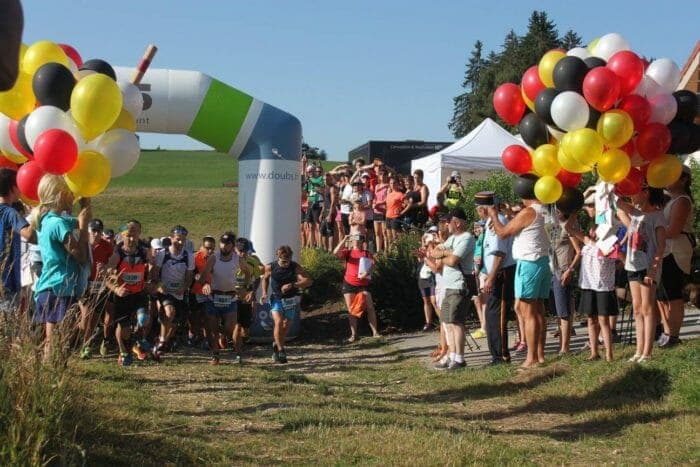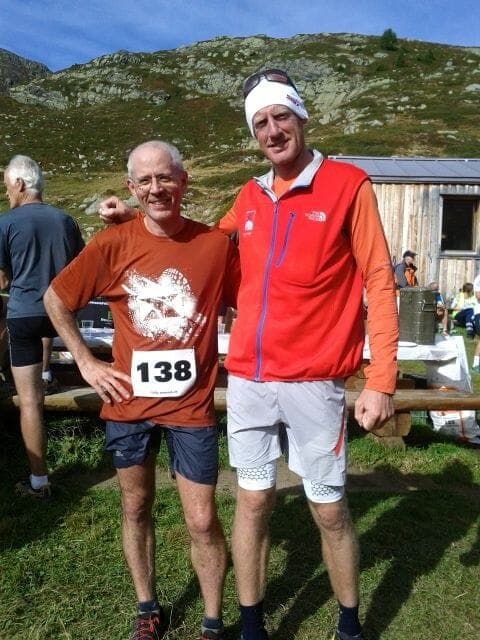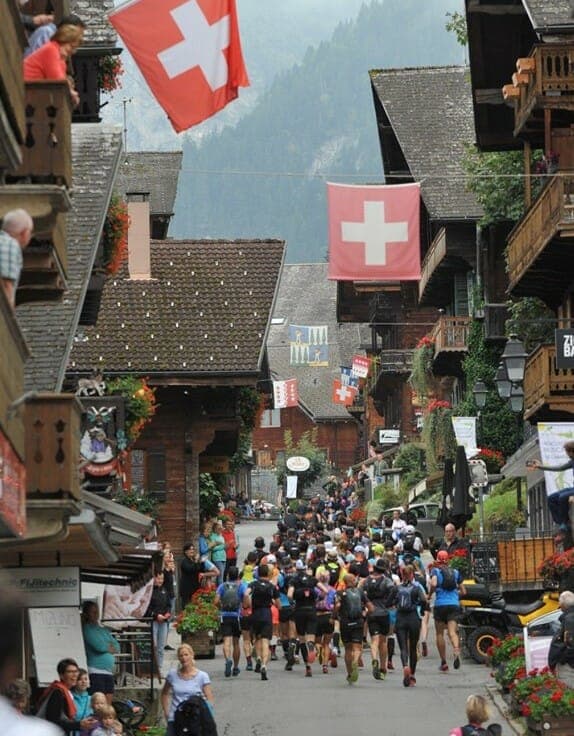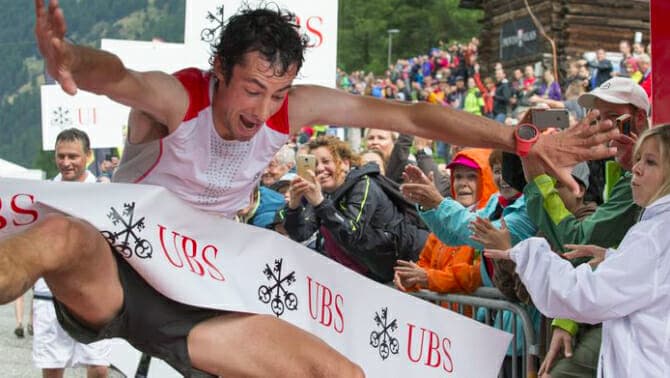

Run the Alps Goes Back to Our Roots

Trail racing in the Alps is not what you think.
I’ll explain. But first let me tell you a story.
Fully-Sorniot, one of my first Alps trail races, is located in the French-speaking part of Switzerland’s mountainous Valais canton. The course is a steep uphill push of 8km with 1600 meters of vert, or dénivélé, in French.
When I crossed the finish line a craggy-faced, smiling septuagenarian dressed in a tweed jacket handed me a glass of white wine. Fendant, specifically, from his Martigny vineyard, located almost literally between my feet, 1.6km below. Thirsty and in a celebratory mood, I downed two glasses in quick succession.
Sounds great, right?
Only I wasn’t thinking much about consequences and— badly dehydrated on a hot August day— I soon found myself sprawled out in a high Alps pasture with fifty other runners, snoozing in a post-run alcoholic stupor under the Valais sun. In time, shadows grew and the high mountain air hinted at a frostiness that would soon arrive. At varying intervals, small groups of us rose, wobbled, and stumbled back down 14 kilometers of rocky, vertiginous trail to call it a day.
The full story of my first Fully-Sorniot here.
That, in one form or another, is pretty much the story of my first decade of trail racing in the Alps.
The Unique Charm of Village Races
Up close, Alps trail running is often very different than how it appears from a distant horizon. The fact is, most trail running in the Alps isn’t made up of marquee brands like Ultraks, Golden Trail, Skyrunning, or UTMB Mont Blanc. Much of it is very much like in the US, where I first started trail running. It’s volunteer-organized, locally based, low-key and very much a good time. There are no live broadcasts, and the biggest name runner when I started exploring the Alps race scene was Manu Vaudan, a wonderfully kind Valaisan, sponsored by his regional bank, who during the week taught school and was a beekeeper to make a few Swiss francs on the side. Gentle and soft spoken off the trail, during a race he morphed into a bad-ass mountain goat.
These races are the very soul of Alps trail running. In Switzerland’s Valais canton alone, there are more than 70 such trail races, loosely affiliated into something called the Valais Cup. As a rule, they don’t really promote themselves. For a foreigner discovering the scene, it took me literally stumbling across a tattered list of races in the corner of a village’s town offices, to fully grasp the extent of these events. No ad agency or marketing firms for them, thank you very much.

Nearly every village seems to have a trail race. Their origin story often connects to the local ski club, whose skiers organized the race as summer training. Many are uphill-only, finishing with lunch at a mountain hut. Prizes are usually a wheel of cheese or dried meat from a local farmer— maybe a basket of les produits terroir if you are lucky. More than once, intrigued locals have asked, “So, you are American? How did you find out about this race? We’ve never had an American run this before!”
Today, of course, these races are easier to find— we have the English-language Race Finder listing right here on the Run the Alps web site, now maintained by Run the Alps Guide Sam Hill. The Race Finder’s own origin dates to pre-Run the Alps days, when an English Alps trail racing document I created was emailed around among friends.
Like the UK’s Fell races or the backyard races around the US, these trail races have a unique charm. You may stop at an aid station high in the mountains, as I once did, only to be offered buttermilk fresh from the farm. (Thanks-but-no-thanks.) You may find yourself scratching your head, wondering how to run through 200 sheep that have suddenly decided to stop— fully stop— your forward progress. Locals out for the day to cheer on the runners may offer you sausage or cheese. Or, yes, you may find yourself running alongside an inspired cow, wondering just how long this four-legged bovine race bandit with the clanging bell is going to keep up. Answer: one kilometer. Cows, it seems, can run fast and are surprisingly agile!

None of this is to say, by the way, that the big-name races are not appealing. They’re just different. For all of the biz-chatter surrounding UTMB and its new partnership with Ironman, you’d have to have a cynic’s cold heart not to be entranced by the pageantry and drama of it all. And Sierre-Zinal, arguably the most competitive trail race in the world? Watching finishers practically fly into Zinal, lined by cheering fans, is a memory that will be with me long after my legs have turned creaky and slowed to a walk. I have been both participant and onlooker in these races, and they too are special in their own way.
Many of our Run the Alps guests and readers come from places distant from the Alps: San Francisco, Sydney, Capetown, Colorado. From these places, the beacons of trail running shine bright: UTMB Mont Blanc, Sierre-Zinal, Eiger Ultra, Tor des Geants, the Mont Blanc Marathon. It’s understandable. Look west from Chamonix, and the horizon glimmers with the likes of Hardrock, Western States, Pikes Peak, Broken Arrow and others. Plenty is lost in the miles between our trail running homes. But underneath it all, here in the Alps, the heart of trail running beats strong at races with names not often uttered outside of their regions: Dents-du-Midi, Argentrail, Glacier 3000, Chandolin, and La Grimpette des Bedjuis.
Our Summer Racing Plans: Going Back to Our Roots
All this summer, the staff and guides here at Run the Alps will be celebrating these lesser-known events— the ones that always make the local paper but never, ever, make Ultrarunning, Trail Runner, or Runners World.
We’ve already started. A few weeks ago, Run the Alps Assistant Manager Emily Geldard and I took part in the 12th edition of the Droit du Catogne, an 11.5km race that was one part vertical kilometer, one part pasture-filled descent back to the village of Sembrancher, just over the Swiss border from our homes in the Chamonix valley. Bib pickup, at the local school, took about two minutes. The pasta lunch, outside next to the playground after the race, was simple and nourishing.
There were 80 starters in our race. (A shorter 6km race had 105 runners, and a kids race had 60 young trail runners taking part.) Emily, who trained hard this spring to ski in the Patrouille des Glaciers ski mountaineer race, placed second, for which the race organizers awarded her a 50 Swiss franc coupon at the local grocery store. Not a bad day’s work, even after the entry fee.
This summer, Run the Alps staff, guides, ambassadors, and friends will be trail running around the Alps, and we’ll share the untold stories about the races that don’t get the lavish media spotlight. The little races with fifty runners at the start line, half of whom know each other, that have been happening each year on the same weekend for decades. With registration fees of 24 Swiss francs — half of which goes to the local ski club— they are the very lifeblood of trail running in the Alps.